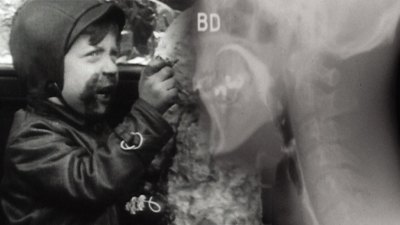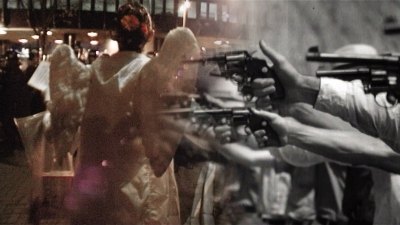| Reviews & Columns |
|
Reviews DVD TV on DVD Blu-ray 4K UHD International DVDs In Theaters Reviews by Studio Video Games Features Collector Series DVDs Easter Egg Database Interviews DVD Talk Radio Feature Articles Columns Anime Talk DVD Savant Horror DVDs The M.O.D. Squad Art House HD Talk Silent DVD
|
DVD Talk Forum |
|
|
| Resources |
|
DVD Price Search Customer Service #'s RCE Info Links |
|
Columns
|
|
|
Bodysong

Birth. Growth. Sex. Violence. Death. Dreams.
These are the six themes of Bodysong (2003), an acclaimed British documentary done in the abstract, music-heavy style of Koyaanisqatsi, Powaqqatsi, and Naqoyqatsi. Directed by Simon Pummell with an accompanying soundtrack by Jonny Greenwood (famous for his work with the music group Radiohead), this film attempts to show the viewer these six stages of life...without glorifying or condoning any of them. Comprised of documentary footage about the six themes above (much of it pre-1970s), Bodysong is a unique and jarring film: it doesn't pull any punches, and makes no apologies.
Needless to say, leave the kids at home.
The footage itself is raw, visceral, beautiful, and extremely uncomfortable to watch at times. The first minutes of the film include several clips of full-on childbirth, and the camera never turns away for a second. Although this section of the film may be particularly hard for some viewers to sit through, the footage immediately following is perhaps the most stirring: as the new mothers are handed their children, a profound look of peace and happiness washes over them. As a male, I'll never experience this type of mother/child bond, but it was truly moving to "witness" it firsthand.
"Growth" focuses on the early stages of development, and often exhibits footage of children and parents at play, and the first steps toward social interaction. Naturally, the "Sex" theme isn't too far behind, and it's easily the most uncomfortable portion of the film's 83-minute running time. Basically, this section holds absolutely nothing back---including hardcore clips of pornography---and is tough to sit through in public, unless you're Bob Crane. In short, I felt like Cybill Shepherd's character in Taxi Driver.

"Violence" is our next theme, which is usually much easier for most American audiences to stomach. Riots, public executions, and armed robberies are all part of this gruesome exhibit, but the worst feeling of all is that these events really happened. After violence, we come to the final two stages of this journey: "Death" and "Dreams". These two sections are the loosest and most experimental, focusing on rituals, the possibility of an afterlife, and other aspects of spirituality.
Naturally, the music had to deliver, since this film was dialogue-free (save for a few closing pieces of footage). The score for the film was almost more like one continuous piece of music, albeit broken down into different movements. As mentioned before, this soundtrack was created by Jonny Greenwood, and Radiohead fans will easily find a few familiar stylings and sounds here. The musical feel was most similar to Radiohead's recent Kid A (2001) and Amnesiac (2002) albums, and featured beautiful strings, piano melodies, jazz-influenced pieces, and enough electronic noodling to make Brian Eno proud.
In short, Bodysong was quite an experience: it was an assault on the senses from beginning to end, which will certainly limit its audience. It's a much darker and more graphic version of the Qatsi films, and was as provocative a film as I've seen in many years. While it wasn't a perfectly-focused effort (and not something you'd want to watch very often), it's a film I'll remember for a long time.

Although Bodysong was released in Europe in 2003 (and captured a BAFTA award for Best Documentary), it finally made its U.S. debut in the most unlikely of places: my hometown of Harrisburg, Pennsylvania. Bodysong was shown at 10:00pm on March 30th, 2004 at the Select Medical IMAX Theater, part of Whitaker Center for Science and the Arts (seen above). NOTE: the film itself was not shot in typical IMAX format, but was still projected to fill about 70% of the massive screen (which makes for a very convincing film experience, believe me).
In essence, Bodysong is a rare film that contains equal parts power and vulnerability. There are no Hollywood actors, no staged car chases, and no formulaic happy ending. This is a film about life, full of powerful footage that forces the viewer to realize the scope of the world around them. Shocking, brutal, explicit, and disarmingly moving are the best words to describe this work of art, and I'd encourage any interested parties to seek this film out. The Region 2 DVD is already available in Europe, and a domestic release will undoubtedly be announced soon. Still, if by the rare chance you get to catch this film in theaters, the experience is substantially more massive.
The Official Website of Bodysong (with DVD information)
The Qatsi Trilogy - DVDtalk.com Review Listing
GreenPlastic.com - Radiohead News & Updates
Randy Miller III is an art instructor and gallery assistant based in Harrisburg, PA, who also enjoys freelance graphic design and illustration. When he's not doing that, he enjoys slacking off, general debauchery, and writing things in third person.
|
| Popular Reviews |
| Sponsored Links |
|
|
| Sponsored Links |
|
|
| Release List | Reviews | Shop | Newsletter | Forum | DVD Giveaways | Blu-Ray | Advertise |
|
Copyright 2024 DVDTalk.com All Rights Reserved. Legal Info, Privacy Policy, Terms of Use,
Manage Preferences,
Your Privacy Choices | |||||||











